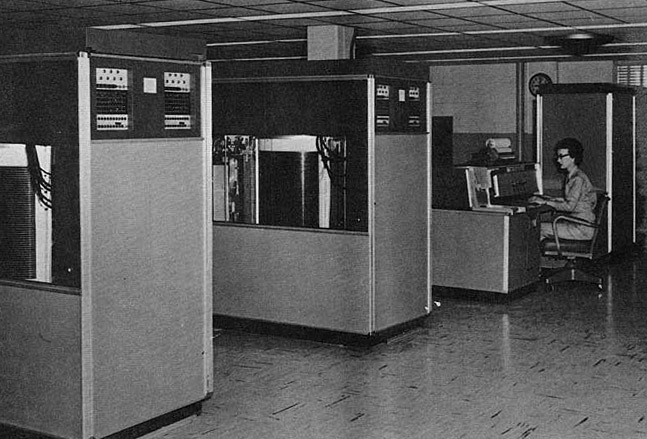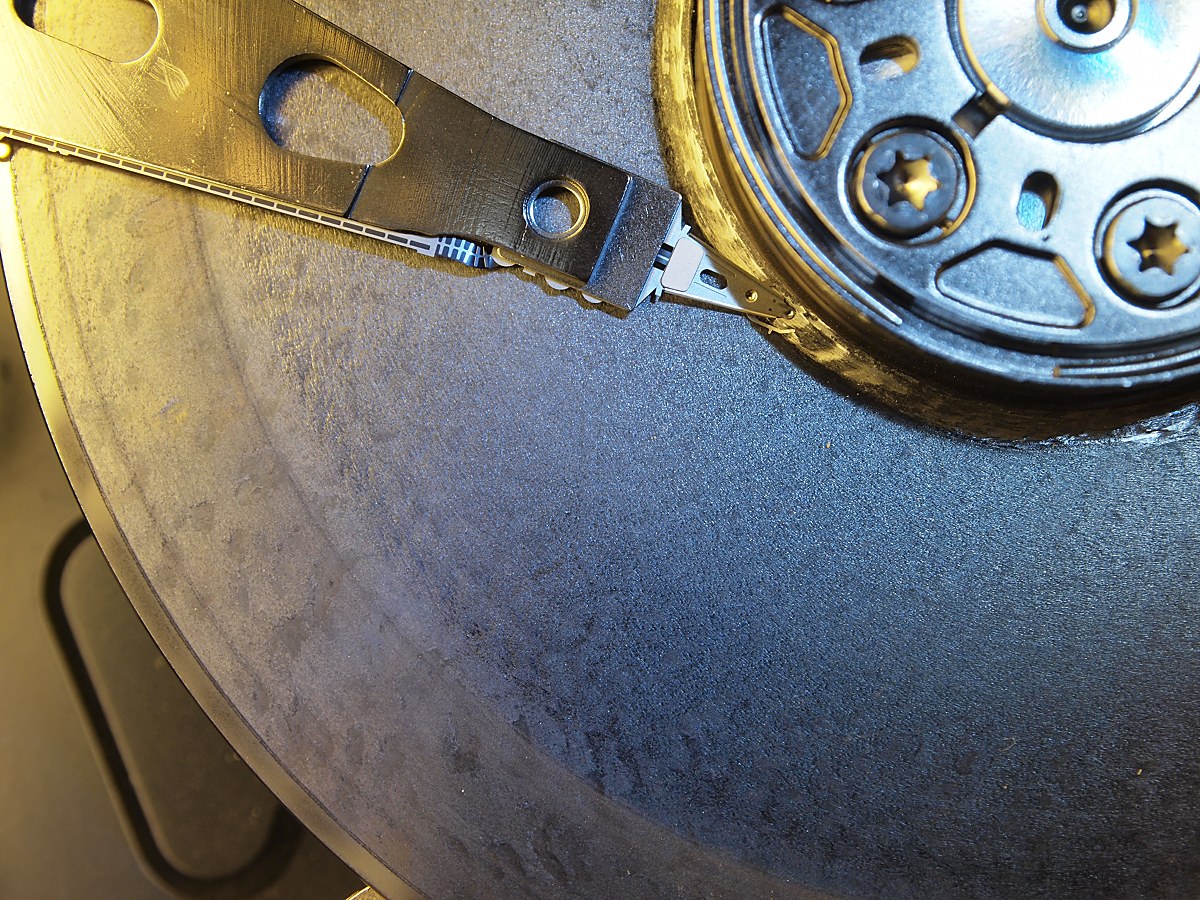|
Flying Height
The flying height or floating height or head gap is the distance between the disk read/write head on a hard disk drive and the platter. The first commercial hard-disk drive, the IBM 305 RAMAC, used forced air to maintain a 0.002 inch (51 μm) between the head and disk. The IBM 1301, introduced in 1961, was the first disk drive in which the head was attached to a "hydrodynamic air bearing slider," which generates its own cushion of pressurized air, allowing the slider and head to fly much closer, 0.00025 inches (6.35 μm) above the disk surface. In 2011, the flying height in modern drives was a few nanometers (about 5 nm). Thus, the head can collide with even an obstruction as thin as a fingerprint or a particle of smoke. Despite the dangers of hard drive failure from such foreign objects, hard drives generally allow for ventilation (albeit through a filter) so that the air pressure within the drive can equalize with the air pressure outside. Because disk ... [...More Info...] [...Related Items...] OR: [Wikipedia] [Google] [Baidu] |
Disk Read/write Head
A disk read-and-write head is the small part of a disk drive which moves above the disk platter and transforms the platter's magnetic field into electrical current (reads the disk) or, vice versa, transforms electrical current into magnetic field (writes the disk). The heads have gone through a number of changes over the years. In a hard drive, the heads ''fly'' above the disk surface with clearance of as little as 3 nanometres. The flying height has been decreasing with each new generation of technology to enable higher areal density. The flying height of the head is controlled by the design of an air bearing etched onto the disk-facing surface of the ''slider''. The role of the air bearing is to maintain the flying height constant as the head moves over the surface of the disk. The air bearings are carefully designed to maintain the same height across the entire platter, despite differing speeds depending on the head distance from the center of the platter. If the head hits ... [...More Info...] [...Related Items...] OR: [Wikipedia] [Google] [Baidu] |
Hard Disk Drive
A hard disk drive (HDD), hard disk, hard drive, or fixed disk is an electro-mechanical data storage device that stores and retrieves digital data using magnetic storage with one or more rigid rapidly rotating platters coated with magnetic material. The platters are paired with magnetic heads, usually arranged on a moving actuator arm, which read and write data to the platter surfaces. Data is accessed in a random-access manner, meaning that individual blocks of data can be stored and retrieved in any order. HDDs are a type of non-volatile storage, retaining stored data when powered off. Modern HDDs are typically in the form of a small rectangular box. Introduced by IBM in 1956, HDDs were the dominant secondary storage device for general-purpose computers beginning in the early 1960s. HDDs maintained this position into the modern era of servers and personal computers, though personal computing devices produced in large volume, like cell phones and tablets, rely on ... [...More Info...] [...Related Items...] OR: [Wikipedia] [Google] [Baidu] |
Hard Disk Drive Platter
A hard disk drive platter (or disk) is the circular disk on which magnetic data is stored in a hard disk drive. The rigid nature of the platters in a hard drive is what gives them their name (as opposed to the flexible materials which are used to make floppy disks). Hard drives typically have several platters which are mounted on the same spindle. A platter can store information on both sides, requiring two heads per platter. Design The magnetic surface of each platter is divided into small sub-micrometer-sized magnetic regions, each of which is used to represent a single binary unit of information. A typical magnetic region on a hard-disk platter (as of 2006) is about 200–250 nanometers wide (in the radial direction of the platter) and extends about 25–30 nanometers in the down-track direction (the circumferential direction on the platter), corresponding to about 100 billion bits per square inch of disk area (15.5 Gbit/cm2). The material of the main ''magnetic medium ... [...More Info...] [...Related Items...] OR: [Wikipedia] [Google] [Baidu] |
IBM 305 RAMAC
The IBM 305 RAMAC was the first commercial computer that used a moving-head hard disk drive (magnetic disk storage) for secondary storage. The system was publicly announced on September 14, 1956,650 RAMAC announcement The 305 RAMAC and the 650 RAMAC were internally announced on September 4, 1956. with test units already installed at the U.S. Navy and at private corporations. RAMAC stood for "Random Access Method of Accounting and Control", as its design was motivated by the need for real-time accounting in business.IBM RAMAC promotional film /ref> History The first RAMAC to be used in the U.S. auto indu ...[...More Info...] [...Related Items...] OR: [Wikipedia] [Google] [Baidu] |
Air Bearing
Air bearings (also known as aerostatic or aerodynamic bearings) are fluid bearings that use a thin film of pressurized gas to provide a low friction load-bearing interface between surfaces. The two surfaces do not touch, thus avoiding the traditional bearing-related problems of friction, wear, particulates, and lubricant handling, and offer distinct advantages in precision positioning, such as lacking backlash and static friction, as well as in high-speed applications. Space craft simulators now most often use air bearings and 3-D printers are now used to make air-bearing-based attitude simulators for CubeSat satellites.Nemanja Jovanovic, et al. Design and Testing of a Low-Cost, Open Source, 3-D Printed Air-Bearing-Based Altitude Simulator for CubeSat Satellites. ''Journal of Small Satellites'' Vol. 8, No. 2, pp. 859–880 (2019). https://jossonline.com/letters/design-and-testing-of-a-low-cost-open-source-3-d-printed-air-bearing-based-attitude-simulator-for-cubesat-satellites/ ... [...More Info...] [...Related Items...] OR: [Wikipedia] [Google] [Baidu] |
IEEE Transactions On Magnetics
''IEEE Transactions on Magnetics'' is a monthly peer-reviewed scientific journal that covers the basic physics of magnetism, magnetic materials, applied magnetics, magnetic devices, and magnetic data storage. The editor-in-chief is Pavel Kabos (National Institute of Standards and Technology). Abstracting and indexing The journal is abstracted and indexed in the Science Citation Index, Current Contents/Physical, Chemical & Earth Sciences, Scopus, CSA databases, and EBSCOhost. According to the ''Journal Citation Reports'', the journal has a recent impact factor The impact factor (IF) or journal impact factor (JIF) of an academic journal is a scientometric index calculated by Clarivate that reflects the yearly mean number of citations of articles published in the last two years in a given journal, as i ... of 1.7. References External links * {{Official website, 1=http://ieeexplore.ieee.org/xpl/RecentIssue.jsp?punumber=20 Physics journals Materials science journals ... [...More Info...] [...Related Items...] OR: [Wikipedia] [Google] [Baidu] |
Hard Drive Failure
A hard disk drive failure occurs when a hard disk drive malfunctions and the stored information cannot be accessed with a properly configured computer. A hard disk failure may occur in the course of normal operation, or due to an external factor such as exposure to fire or water or high magnetic fields, or suffering a sharp impact or environmental contamination, which can lead to a head crash. The stored information on a hard drive may also be rendered inaccessible as a result of data corruption, disruption or destruction of the hard drive's master boot record, or by malware deliberately destroying the disk's contents. Causes There are a number of causes for hard drives to fail including: human error, hardware failure, firmware corruption, media damage, heat, water damage, power issues and mishaps. Drive manufacturers typically specify a mean time between failures (MTBF) or an annualized failure rate (AFR) which are population statistics that can't predict the behavior of ... [...More Info...] [...Related Items...] OR: [Wikipedia] [Google] [Baidu] |
Hermetic Seal
A hermetic seal is any type of sealing that makes a given object airtight (preventing the passage of air, oxygen, or other gases). The term originally applied to airtight glass containers, but as technology advanced it applied to a larger category of materials, including rubber and plastics. Hermetic seals are essential to the correct and safe functionality of many electronic and healthcare products. Used technically, it is stated in conjunction with a specific test method and conditions of use. Uses Some kinds of packaging must maintain a seal against the flow of gases, for example, packaging for some foods, pharmaceuticals, chemicals and consumer goods. The term can describe the result of some food preservation practices, such as vacuum packing and canning. Packaging materials include glass, aluminum cans, metal foils, and gas impermeable plastics. Some buildings designed with sustainable architecture principles may use airtight technologies to conserve energy. Under s ... [...More Info...] [...Related Items...] OR: [Wikipedia] [Google] [Baidu] |
Helium
Helium (from el, ἥλιος, helios, lit=sun) is a chemical element with the symbol He and atomic number 2. It is a colorless, odorless, tasteless, non-toxic, inert, monatomic gas and the first in the noble gas group in the periodic table. Its boiling and melting point are the lowest among all the elements. It is the second lightest and second most abundant element in the observable universe (hydrogen is the lightest and most abundant). It is present at about 24% of the total elemental mass, which is more than 12 times the mass of all the heavier elements combined. Its abundance is similar to this in both the Sun and in Jupiter, due to the very high nuclear binding energy (per nucleon) of helium-4, with respect to the next three elements after helium. This helium-4 binding energy also accounts for why it is a product of both nuclear fusion and radioactive decay. The most common isotope of helium in the universe is helium-4, the vast majority of which was formed during t ... [...More Info...] [...Related Items...] OR: [Wikipedia] [Google] [Baidu] |
Head Crash
A head crash is a hard-disk failure that occurs when a read–write head of a hard disk drive makes contact with its rotating platter, slashing its surface and permanently damaging its magnetic media. It is most often caused by a sudden severe motion of the disk, for example the jolt caused by dropping a laptop to the ground while it is operating or physically shocking a computer. Head details A head normally rides on a thin film of moving air entrapped at the surface of its platter (some drives manufactured by Conner Peripherals in the mid-1990s used a thin liquid layer instead). The distance between the head and platter is called the flying height. The topmost layer of the platter is made of a Teflon-like material that acts like a lubricant. Underneath is a layer of sputtered carbon. These two layers protect the magnetic layer (data storage area) from most accidental touches of the read-write head. The disk read-and-write head is made using thin film techniques that in ... [...More Info...] [...Related Items...] OR: [Wikipedia] [Google] [Baidu] |



.gif)



